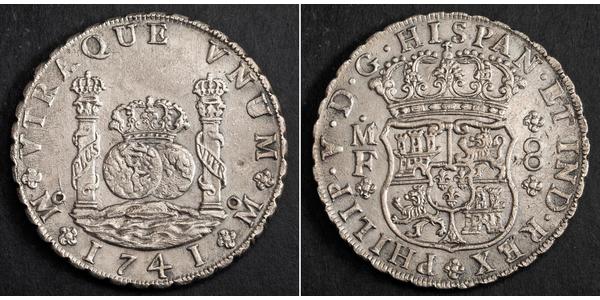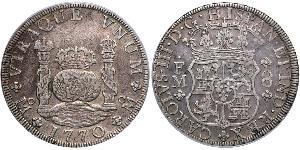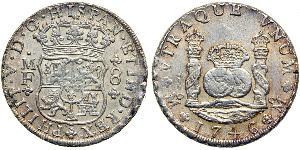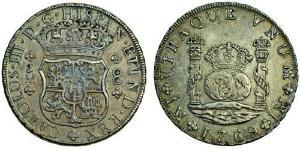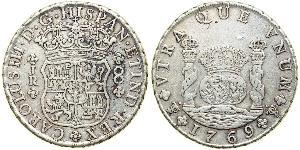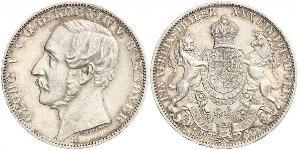(sold for $570.0)
1741, Mexico, Philip V. Colonial Silver 8 Reales Dollar Coin. Shipwreck Coin!
Mint Year: 1741 Mint Mark: Mo (Mexico) Reference: 1741-MoMF, KM-103. R! Denomination: 8 Reales (Quarter Pillar Dollar) Assayers: Manuel de la Pena & Francisco de la Pena (MF) Condition: This coin has definitely the appearance (XF-AU, cleaned, with minimal dark oxidation deposits remained and some serious salt-water corrosion) of a sea-salvaged coin, which supports the suggestion that it came from the Hollandia shipwreck, however there are no documents available for this provenance! Weight: 26.80gm Diameter: 38mm Material: Silver
Obverse: Crowned Spanish coat-of-arms, assayers' initials and value on either side. Latin Legend: * PHILIP . V . D . G . HISPAN . ET IND . REX * / .MF* / *8* Expanded: PHILIP V DEI GRATIA HISPANIARUM ET INDIARUM REX Translation: "Philip V by the Grace of God, King of the Spains and the Indies"
Reverse: Crowned hemispheres, set on Gibraltar, between crowned and banner-entwined pillars of Hercules. Waves below. Latin Legend: VTRAQUE VNUM * Mo * I74I * Mo * Translation: "On both sides / Unity"
Hollandia was a ship of the Dutch East India Company (Dutch: Vereenigde Oost-Indische Compagnie; VOC) which wrecked on Annet, Isles of Scilly on 13 July 1743 causing 276 fatalities. The wreck was discovered in 1971 by Rex Cowan, a London attorney. Hollandia was built by the Dutch East India Company in 1742 in Amsterdam to a new design, as a 32 gun, 700 ton ship with a length of 42 metres (138 ft). On 3 June 1743 she left Texel as part of a Batavia bound fleet carrying a large amount of trade coin and several important passengers. On 13 July 1743 she became separated from the fleet and struck Gunner Rock near Annet, Isles of Scilly in the early hours of the morning, sinking nearby with the loss of all hands. Rex Cowan began his search for Hollandia in 1968, starting with Dutch and English archives and using advanced (for the time) equipment such as a proton magnetometer, finally locating the wreck on 16 September 1971. A large quantity of coins was recovered, as well as bronze cannons and mortars.
Pillar coins were a great improvement over cobs in that they were of a uniform size and weight without cracks or uneven edges. They had a deep full strike with all information clearly visible and were difficult to clip or counterfeit. Denominations for this new coinage included the one half, one, two, four and eight reales coins.
Philip was the second son of Louis, le Grand Dauphin and Maria Anna of Bavaria, known as Dauphine Victoire. He was a younger brother of Louis, duc de Bourgogne and an uncle of Louis XV of France.
His paternal grandparents were Louis XIV of France and Maria Theresa of Spain. His maternal grandparents were Ferdinand Maria, Elector of Bavaria and Adelaide Henriette of Savoy, the daughter of Victor Amadeus I, Duke of Savoy.
Philip helped his Bourbon relatives to make territorial gains in the War of the Polish Succession and the War of the Austrian Succession by reconquering Naples and Sicily from Austria and Oran from the Ottomans. Finally, at the end of his reign Spanish forces also successfully defended their American territories from a large British invasion during the War of Jenkins' Ear.
During his reign, Spain began to recover from the stagnation it had suffered during the twilight of the Spanish Habsburg dynasty. Ferdinand VI of Spain, his son by his first queen Maria Luisa of Savoy, succeeded him.
Philip was afflicted by fits of manic depression and increasingly fell victim to a deep melancholia. His second wife, Elizabeth Farnese, completely dominated her passive husband. She bore him further sons, including another successor, Charles III of Spain. He was later helped with his affliction by the castrato singer Carlo Broschi, famously known as Farinelli, who, for twenty years, sang the same four arias each night to the king before he went to sleep.
Philip died on 9 July 1746 and was buried in his favorite Royal Palace of La Granja de San Ildefonso.

|
Posted by:
anonymous 2021-01-27 |

